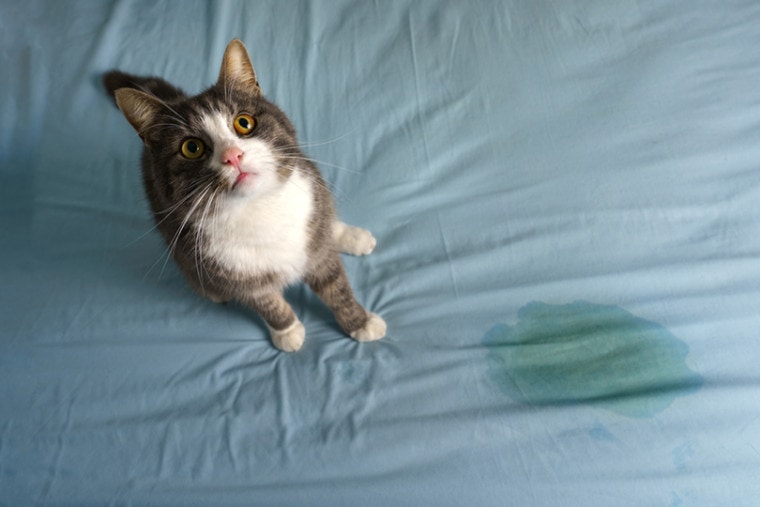
Click to Skip Ahead
If you have cats, you’ve had to deal with eliminating the smells that they leave behind. One of the worst smells (and one of the hardest to get rid of) is the smell of cat pee. Whether you are litter training a young kitten that hasn’t quite caught on yet, you have a cat with health issues, or your cat is peeing outside the box when you’re away from home, you need a way to get rid of the smell.
Let’s look at six different ways to get rid of cat pee smell for good and a few reasons that your cat might be peeing outside their litter box in the first place.
The 8 Ways to Get Rid of Cat Pee Smell
If the mess that you are trying to clean is fresh, blot or wipe away as much of the cat urine as possible with a paper towel or old cloth. Then, consider using one of the following six options.
Removing Cat Pee Smells From Floors
1. Baking Soda/Pet Odor Remover and Vacuuming for Odors in Carpet
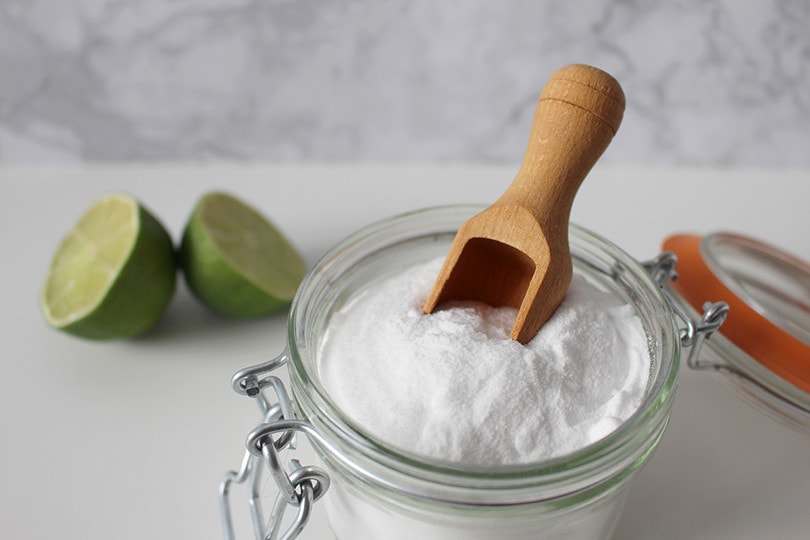
Materials Needed:
Cat urine odors in carpet can be the most challenging to get rid of because the urine soaks right through the carpet fibers to the padding underneath. Since cats have a superior sense of smell, it’s important to get every last bit out of your carpet. Otherwise, your cat will return to the same spot again and again because to them, it smells like a bathroom.
This method works well at removing relatively recent smells from carpeted surfaces. But for stains that have been lingering for a long time, such as old cat pee smells from a prior resident, you may need a more drastic solution.
Using Baking Soda:
Scrub the urine stain thoroughly with club soda. Use a toothbrush to rub the soda into the stain. Let it air dry. Sprinkle the area with baking soda, and let the baking soda sit for 10–15 minutes to soak up any lingering smells. Then vacuum. Depending on how long the smell has been sitting, you may have to repeat the process several times.
Using Pet Odor Remover:
Using a commercial pet odor remover product that is designed to break down the particles in cat urine that cause odor can go a long way toward getting rid of the smell. For powder cleaners, you will sprinkle these on your carpet, let them sit for the period of time designated by the manufacturer, and then vacuum. Some cleaners also come as sprays and can be used in a similar fashion.
2. Vinegar
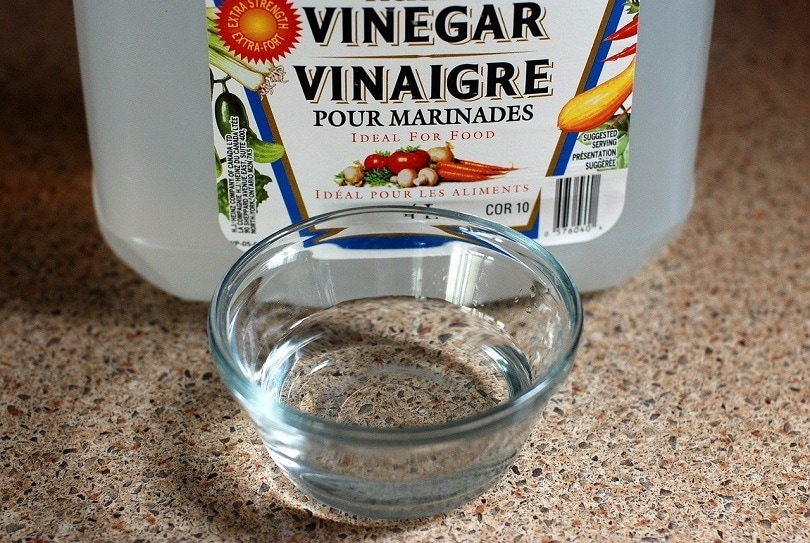
Materials Needed:
The acidic nature of vinegar means that it can neutralize the bacteria in fresh cat pee and kill the smell.
How to use it:
Mix equal parts white or apple cider vinegar and water in a spray bottle. Spray the vinegar solution onto the affected area. This solution can be used on floors or furniture. Blot away the vinegar solution with a paper towel or old cloth. Repeat spraying and blotting until the smell is gone.
Vinegar does a fantastic job at neutralizing odors in fresh cat urine spots. However, this solution only works on fresh stains, where the vinegar can be sprayed directly onto the offending urine. For bacteria that has soaked down into carpet or upholstery fibers, some smell may linger.
3. Enzymatic Cleaners
If you're trying to find an enzyme cleaner that does it all, we highly recommend our favorite cleaner, the Hepper Advanced Bio-Enzyme Pet Stain & Odor Eliminator Spray.
- ADVANCED ENZYMATIC CLEANER - Penetrates the most stubborn smells and stains at the deepest molecular...
- FOR ANY MESS, ON ANY SURFACE - This pet odor eliminator cleans your carpets, floors, furniture,...
- FRESH, NATURAL ODOR - Our unique formulation doesn't rely on dangerous or unpleasant chemical...
It permanently removes the very worst stains and smells you can imagine and makes clean up a breeze. There's even a 100% satisfaction guarantee! Click here to order a bottle today.
At Pet Keen, we’ve admired Hepper for many years, and decided to take a controlling ownership interest so that we could benefit from the outstanding products of this cool cat company!
Materials Needed:
Commercially made enzymatic stain and odor removers are ideal for removing cat urine odors. These cleaners work because they break down the sulfur, ammonia, and other compounds in cat urine, feces, and vomit. This is also why they do a much better job at getting rid of old cat pee smells than baking soda or vinegar.
How to use it:
Follow the instructions on the manufacturer’s label for use. These products come in several different forms, including powder, liquid, or spray. Each will have different instructions for how much to apply.
In general, you will thoroughly spray or spread the enzymatic cleaner on the affected area and let it sit for 15 to 30 minutes. Then, blot or scrub off the solution and let it air dry.
4. Hydrogen Peroxide
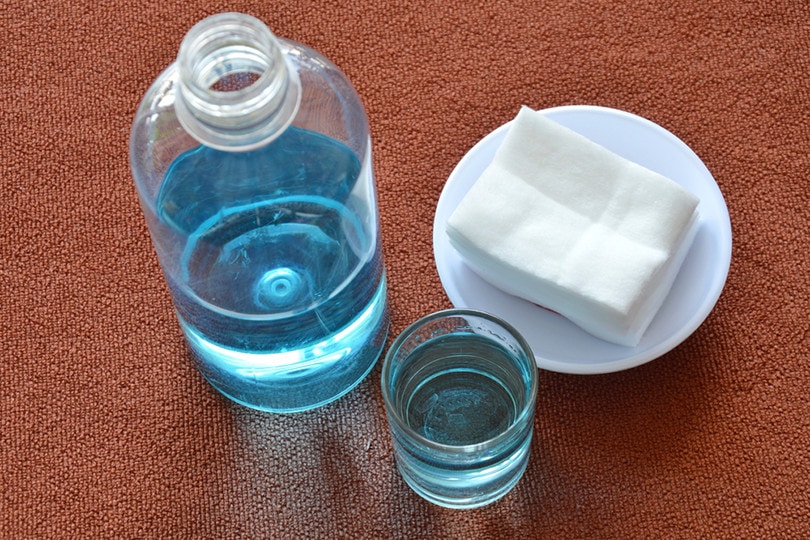
Materials Needed:
Hydrogen peroxide is a household product capable of oxidizing or breaking down the ammonia in cat pee. Mixing it with dishwasher detergent will help your floor smell clean and fresh.
It’s important not to use hydrogen peroxide on furniture, upholstery, or carpet, as it can discolor fabric. However, it is a great solution for hard floors.
How to use it:
Mix equal amounts of hydrogen peroxide and water into a spray bottle. If you choose, add 1 teaspoon of liquid dishwasher detergent to the solution. Spray on the solution, and thoroughly blot the solution off the affected area. Test this method in a spot that you can easily cover to make sure it won’t stain.
5. OxiClean
Materials Needed:
If your cat is peeing on non-carpeted floors like ceramic tile, grout, vinyl plank, laminate, hardwood, or linoleum, you need to get a deep clean that removes the odor. OxiClean Versatile Stain Remover has over 101 labeled uses, and cleaning up pet urine happens to be one of them.
When cleaning hard surfaces, you need a non-ammonia and non-vinegar-based solution. It’s also important not to use any products that contain chlorine bleach. Cat urine contains ammonia, and dangerous gases are created when it mixes with bleach.
How to use it:
Fill a bucket with hot water. Using the provided OxiClean scoop, pour one scoop of OxiClean into the bucket. Stir the solution with a long-handled spoon to mix until the powder is dissolved. Apply the solution to your floor, and allow it to sit for 1–5 minutes. Use a sponge or mop to clean the affected area. Dump the OxiClean solution, and refill the bucket with cold water. Re-mop the floor with water to rinse off any residue.
6. Professional Carpet Cleaning
Materials Needed:
Sometimes, you just can’t pinpoint where the cat pee smell is coming from, particularly if it’s an old smell. Cleaning suspected areas using one of the previous methods may help you find the source of the offending odor. If these DIY options don’t remove the cat pee smell, it might be time to call in help.
If the smell is in a carpeted area, you can use a carpet cleaner vacuum to deep-clean your carpet. In extreme cases, where the smell has spread through furniture, floors, and even walls, it could be necessary to get a professional to clean the whole area.
Removing Cat Pee Smells for Clothes, Bedding, or Towels
7. Laundry Additive
Materials Needed:
If your cat pee smell is coming from your bedding or your laundry basket, the good news is that you can wash out the smell, but the bad news is that regular laundry detergent won’t cut it. You need a special cleaner to neutralize the odor. There are a few options to choose from:
How to use it:
Wash the linens in cold water, adding the odor-eliminator product of your choice according to the label. Make sure to line-dry the item, as heat from the dryer can “set” the smell. If possible, hanging the items to air dry outdoors in the sun is the best option.
8. Ozone — The last resort
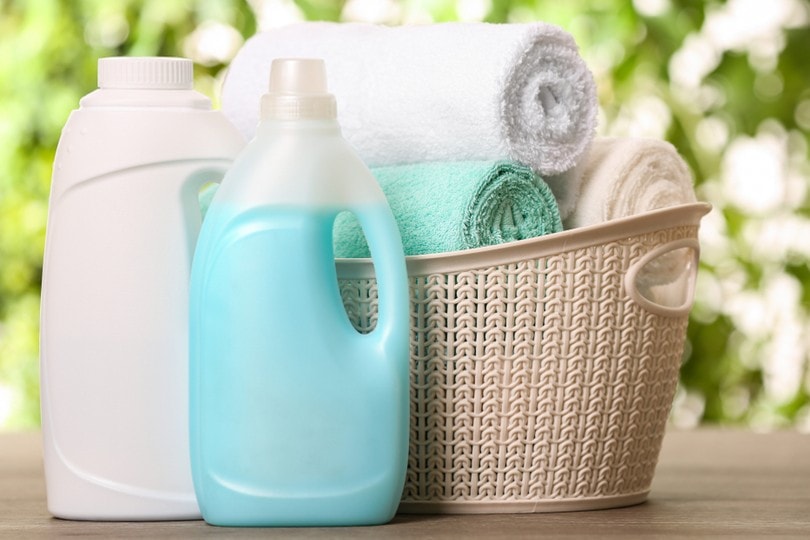
Materials Needed:
There is one final option to get rid of cat pee smells for valuable items that can’t be soaked in baking soda, vinegar, or enzymatic cleaner. It can remove odors from things like shoes, suitcases, or pieces of artwork. You’ll need to find a specialty dry cleaner with an ozone room. This might not be an option for cleaning floors, furniture, or walls, but it can save expensive clothing or valuables.
How to use it:
Quickly remove as much urine as possible from the item using plain water to gently blot the stain. Continue blotting until your paper towel or old cloth comes away clear. Let the item air dry. If the cat pee smell lingers, take the item to a dry cleaner that has an ozone room to have it ozone-treated. The item is usually scent-free in about 24 hours.
Why Cats Pee Outside the Litter Box
Litter box issues are frustrating, especially when they result in your home smelling like cat pee. Most of the time, your cat peeing outside the litter box is a sign that something’s wrong. Common reasons that a cat ceases to use their litter box include:
If you find that your litter-trained cat has started peeing outside of their litter box, your first call should be to the vet. If there is a medical issue, it can be properly addressed. Otherwise, you can determine if it’s a behavior issue.
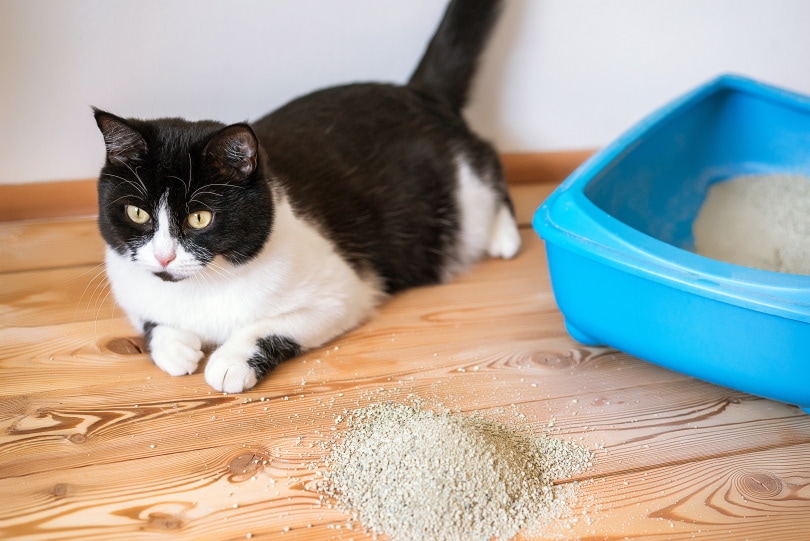
Why Does Cat Pee Smell So Bad?
Cat pee is one of the most stubborn smells around. It’s not that it’s much different from any other kind of animal urine; it’s that cats are sneakier about where they pee. The mess tends to sit around for a while, enabling the bacteria in the urine to decompose and give off a pungent, strong ammonia odor. After a while, cat pee starts to emit mercaptans, which are the same compounds that make skunk spray so stinky (also a notoriously hard smell to remove).
Older cats are likely to have stronger-smelling urine than younger cats, as their kidneys don’t process urine as well. Unneutered male cats also have strong-smelling pee, as their urine contains hormones.
Conclusion
No matter the reason that your cat is peeing outside the litter box, getting the area clean is key to preventing repeat behavior — and removing the smell from your home. This guide contains tried-and-true methods for removing cat pee smell, with options for every type of surface. Whether it is your floor, carpet, furniture, or bedding, there are ways to get rid of the smell.
Featured Image Credit: Creative Cat Studio, Shutterstock









